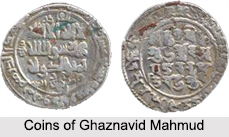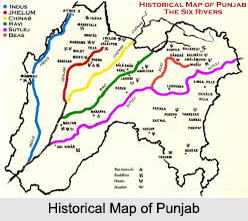 Medieval History of Punjab began with the downfall of Hephthalites after they were defeated by Sassanid and Gokturk. The Hephthalites were defeated by a Sassanid and Gokturk alliance in 557 AD, and the Hephthalite remnants formed smaller Kushano-Hephthalite or Turki Shahi kingdoms that were dominated by Persia. Taank and Kapisa both dominated Gandhara.
Medieval History of Punjab began with the downfall of Hephthalites after they were defeated by Sassanid and Gokturk. The Hephthalites were defeated by a Sassanid and Gokturk alliance in 557 AD, and the Hephthalite remnants formed smaller Kushano-Hephthalite or Turki Shahi kingdoms that were dominated by Persia. Taank and Kapisa both dominated Gandhara.
Invasion of Arabs
The Muslim Arabs rose to power and gradually came towards South Asia in the mid 7th century. In 711-713 AD, Arab armies from the Umayyad caliphate of Damascus conquered Sindh and advanced into the present-day southern Punjab, occupying Multan, which was later to become a centre of the Ismaili sect of Islam. The conquest of Sindh and southern Punjab was the first and last great achievement of the Arabs in India. The Arabs tried to invade India but were defeated by Vikramaditya II of the Chalukya dynasty and south Indian general Dantidurga of the Rashtrakuta dynasty in Gujarat and by Nagabhata of the Pratihara Dynasty in Malwa in the early 8th century. They failed to end their dominance beyond Sindh and southern Punjab.
Role of Pratiharas
The Pratiharas who played a major role in confining the Arabs within Sindh ruled over a large empire with its capital at Kannauj, during the 9th and 10th centuries.
Rule of Hindu Shahis
The Hindu Shahis were ruling from Kabul in modern Afghanistan captured some parts of Punjab. The Brahmana dynasty ruled in Punjab, between the rivers Satluj and Sindh. Bachan Pala, Ram Singh, Bir Singh and Prithvi Pala of his family ruled in Punjab. The kingdoms of Kannauj, Punjab, Kabul and Samarqand all prospered mainly due to international trade caravans passing through their respective dominions.
Invasion of Turks in Punjab
In the later era, The Mahmud of Ghazni and Sabuktagin ascended its throne in 977. He first added Muslim ruled Bust, Dawar, Qusdar, Tukhristan and Gaur to his kingdom and started nibbling at the border territories of the Shahi king at Waihind. Muhammad of Ghazni invaded Punjab many times and captured.
Rule of Ghaznavids
 The Mahmud`s successors, known as the Ghaznavids, ruled for 157 years. Their kingdom gradually shrank in size following his death, and was racked by bitter succession struggles. The Hindu Rajput kingdoms of modern Rajasthan and Gujarat conquered the eastern Punjab, and by the 1160s, the line of demarcation between the Ghaznavid state and the Hindu kingdoms approximated to the present-day boundary between India and Pakistan. The Ghorids of central Afghanistan occupied Ghazni around 1150, and the Ghaznavid capital was shifted to Lahore. Muhammad Ghori conquered the Ghaznavid kingdom, occupying Lahore in 1186-1187, and later extending his kingdom past Delhi into the Ganges-Yamuna Doab.
The Mahmud`s successors, known as the Ghaznavids, ruled for 157 years. Their kingdom gradually shrank in size following his death, and was racked by bitter succession struggles. The Hindu Rajput kingdoms of modern Rajasthan and Gujarat conquered the eastern Punjab, and by the 1160s, the line of demarcation between the Ghaznavid state and the Hindu kingdoms approximated to the present-day boundary between India and Pakistan. The Ghorids of central Afghanistan occupied Ghazni around 1150, and the Ghaznavid capital was shifted to Lahore. Muhammad Ghori conquered the Ghaznavid kingdom, occupying Lahore in 1186-1187, and later extending his kingdom past Delhi into the Ganges-Yamuna Doab.
Rule of Delhi Sultanate in Punjab
Delhi Sultanates ruled from Delhi between 1206 and 1526, when the last was replaced by the Mughal dynasty. In 1160, Muhammad Ghori, a Turkic ruler, conquered Ghazni from the Ghaznavids and became its governor in 1173. He for the first time named Sindh Tambade Gatar roughly translated as the red passage. He marched eastwards into the remaining Ghaznavid territory and Gujarat in the 1180s, but was rebuffed by Gujarat`s Hindu Solanki rulers. In 1186-87, he conquered Punjab, bringing the last of Ghaznevid territory under his control and ending the Ghaznavid Empire. Muhammad Ghori`s successors established the Delhi Sultanate.
Rule of Mughals in Punjab
Punjab was later added to Mughal Map after the decline of Delhi Sultanates. The Lahore Fort is one of the most famous landmarks left behind from the empire. In 1526, Babur swept across the Khyber Pass and founded the Mughal Empire. However, his son Humayun was defeated by the Afghan warrior Sher Shah Suri in the year 1540, and Humayun was forced to retreat to Kabul. After Sher Shah died, his son Islam Shah Suri became the ruler of North India from 1540-53, on whose death his prime minister, Hemu who had won 22 battles continuously against Afghans and Mughals during 1553-56, from Punjab to Bengal ascended the throne and ruled North India from Delhi. He was defeated by Emperor Akbar`s forces in the Second Battle of Panipat on 6th November 1556.
Rule of Durranis and Marathas
After the death of Aurangazeb, Marathas and Durrani rule some parts of Punjab for a short period of time. In 1747, the Durrani kingdom was established by a Pakhtun general, Ahmad Shah Abdali.
Rise of Sikhs
In 1757, the Sikhs were persistently ambushing guards to loot trains. They conquered total Punjab and ruled here till the British came into power.



















